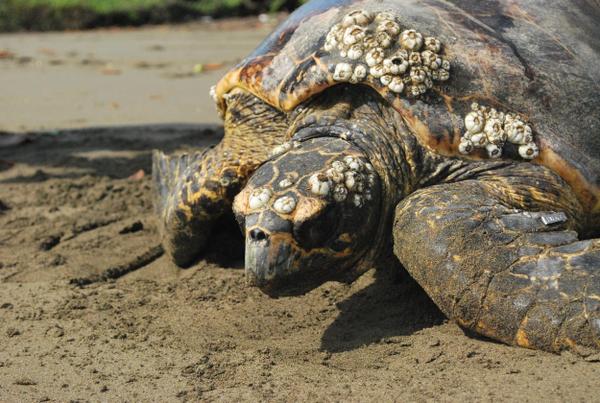

Crabs and flocks of gulls voraciously prey on the young turtles during this short scamper. The most dangerous time of their lives comes when hatchlings make the journey from their nests to the sea. At this stage the turtles retreat to the sea, leaving the eggs, which will hatch in about 60 days. They dig a pit in the sand, fill it with 130 to 160 eggs, and then cover it.

The nesting procedure begins when the turtles leave the sea to choose an area to lay their eggs. Every two to five years, female hawksbills return to the beaches where they were born to nest, which normally takes place in shallow waters close to the shore. Like other sea turtles, hawksbills make incredible migrations in order to move from feeding sites to nesting grounds, normally on tropical beaches. Their hard shells protect them from many predators, but they still fall prey to large fish, sharks, crocodiles, octopuses, and humans. Hawksbills are omnivorous and will also eat mollusks, marine algae, crustaceans, sea urchins, fish, and jellyfish. These highly migratory reptiles help maintain a healthy coral reef ecosystem. They avoid deep waters, preferring coastlines where the sponges they like to feed on are abundant, and sandy nesting sites are within reach. Hawksbill turtles are found throughout the tropical waters of the Atlantic, Pacific, and Indian Oceans. Male hawksbills have longer claws, thicker tails, and somewhat brighter coloring than females. A further distinctive feature is a pair of claws adorning each flipper. The hawksbill turtle’s tapered head ends in a sharp point resembling a bird’s beak, hence its name. Their strikingly colored carapace is serrated and has overlapping scutes, or thick bony plates. While young, their carapace, or upper shell, is heart-shaped, and as they mature it elongates. Not particularly large compared to other sea turtles, hawksbills grow up to about 45 inches in shell length and 150 pounds in weight. You can find hawksbill sea turtles in over 108 countries’ coastal bodies of water.Current Population Trend: Decreasing What is the hawksbill turtle?.They ultimately are a better source for reef fish to feed. Without the hawksbill turtles, sponges would have the skill to overgrow corals and suffocate reefs. They live mainly on the coral’s sponges it has turned these animals into key support for the coral reefs.In Japan, the hawksbill sea turtle shells have been part of the traditional culture for 300 years and are used as traditional wedding dresses in this century.They have existed for the last 100 million years.

Hawksbill sea turtles have been swimming in the oceans for much longer than humans have been on the Earth.The largest colony in the world nests on the Milman Island in Queensland, Australia.



 0 kommentar(er)
0 kommentar(er)
